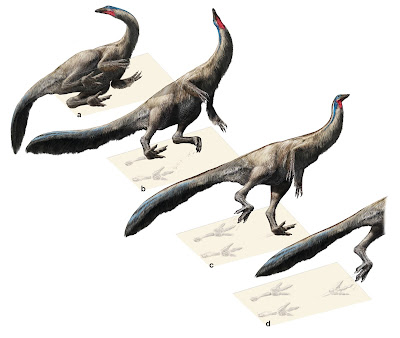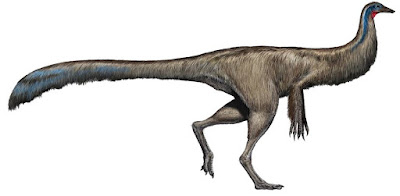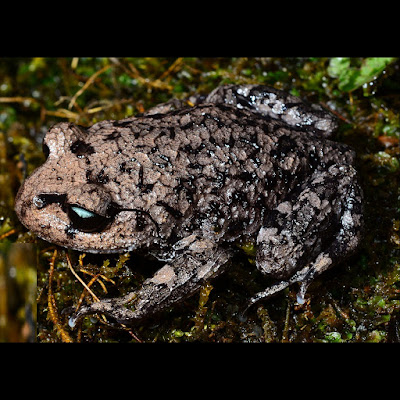[Most Recent Entries] [Calendar View]
Thursday, August 11th, 2016
| Time | Event | ||||
| 12:16a | [Paleontology | Ichnotaxa • 2016] Crouching Theropod at The Seaside. Matching Footprints with Metatarsal Impressions and Theropod Authopods: A Morphometric Approach
Abstract We compare theropod footprints with elongate metatarsal prints from central Italy with known autopod structures in major theropod groups, in order to more accurately define the trackmaker attribution. Our work, using morphometric analysis, shows the considerable potential of explorative methods such as PCA (principal component analysis) and cluster analysis when describing important characters for a given taxonomic group (body and ichnofossils) and identifying important anatomical regions. Moreover, the results of the analysis suggest that the putative trackmaker is likely a member of Ornithomimosauria, with significant affinities in the posterior autopod structure with the genus Struthiomimus. The fundamental importance of integrating both osteological and ichnological data, when investigating locomotor and behavioural hypotheses, is highlighted. This approach could also contribute positively to the complex cognitive process of trackmaker identification and be favourable for the attainment of a more natural definition of ichnotaxa. Keywords: dinosaurs; footprints; Cretaceous; Ornithomimosauria; Italy; palaeobiogeography
Conclusions Our work highlights the great potential of morphometric methods to describe specific characters of a given taxonomic group (both in body fossils and in footprints) more objectively, as already convincingly pointed out recently in the literature (Castanera et al. 2015).These approaches integrate morphometric analysis with footprint morphology and differential impression depth (‘footprint holomorphy’ sensu Romano, Citton & Nicosia,2016), and may shed light on taxonomically relevant characters but also on the biomechanical properties and importance of selected anatomical regions.The latter, cross-checked and plotted on a phylogenetic analysis, can be pivotal for understanding in which particular node and branch a specific morphology, or even a particular behavioural trait, has been acquired.Such integrative approaches also shed light on the dispersal of different clades and different palaeobiogeographical models. In this study, we consider it likely that dinosaurs could reach the Apenninic Carbonate Platform only through migration routes from Gond-wana through the Adria region. The identification of a struthiomimid-like theropod as the putative trackmaker of the new Italian material further supports that putative Ornithomimosauria were present in Gondwana, as pre-viously suggested by other Italian tracks and skeletal material from South Africa. Ichnological data proved to be once again a crucial source of evidence, especially in cases where the body-fossil record results are virtually absent. As we have experienced in recentyears, ichnology has passed, in all respects, from a mere curiosity or corollary of vertebrate palaeontology, to acritical mass of ‘pawing’ often unique evidences and inferences. Marco Romano and Paolo Citton. 2016. Crouching Theropod at The Seaside. Matching Footprints with Metatarsal Impressions and Theropod Authopods: A Morphometric Approach. Geological Magazine. FirstView; 1-17. DOI: 10.1017/S0016756816000546 | ||||
| 12:38a | [Crustacea • 2016] Indochinamon chuahuong • A New Species of the Genus Indochinamon Yeo & Ng, 2007 (Brachyura: Potamidae) from northern Vietnam
Abstract A new species of potamid freshwater crab, Indochinamon chuahuong, is described from Ha Noi, northern Vietnam. The new species can be distinguished from all other Indochinamon species by a suite of characters, including a carapace broader than long; an anterolateral margin that is convex and distinctly serrated; longer ambulatory legs than its congeners; and the terminal segment of the male first gonopod being curved outwards, with a very low dorsal flap. Key words. Vietnam, Crustacea, Brachyura, Potamidae, new species, taxonomy TAXONOMY Family Potamidae Ortmann, 1896 Subfamily Potamiscinae Ortmann, 1896 (sensu Yeo & Ng, 2003) Indochinamon Yeo & Ng, 2007 Indochinamon chuahuong, new species Diagnosis. Carapace broader than long (mean 1.4 times), anterolateral margin convex, distinctly serrated; the brachial region slightly swollen when viewed dorsally. Ambulatory legs relatively long. G1 broad, gently sinuous; terminal segment relatively short, about 0.4 times the length of the subterminal segment, about 3.3 times longer than broad, distally curved outwards, outer margin swollen at base, with very low, narrow dorsal flap. Size. This species is quite large, with the largest recorded male specimens measuring 76.1× 53.0 mm. From what has been published, Indochinamon chuahuong is one of largest freshwater crabs known from Vietnam (Yeo & Ng, 2007; Nasure et al., 2011; Dang & Ho, 2012). Etymology. The new species is named after the type locality, Chua Huong. The name is used as a noun in apposition. Remark. This new species can be separated from congeners by a suite of characteristics, including broader carapace; distinctly serrated, convex anterolateral margin; long ambulatory legs; G1 terminal segment curved outwards, with very low dorsal flap visible only from dorsal. Nevertheless, the most important characters that distinguish the new species from the other species of the genus Indochinamon are the prominently serrated anterolateral margins and the distinctly long ambulatory legs. Only four species of Indochinamon (I. chuahuong, I. bavi, I. kimboiense and I. phongnha) possess a dorsal flap (protuberance of ventral outer surface) at the terminal segment of the G1. However, I. chuahuong can be distinguished from the other three species by a combination of morphological characters (Table 1). Carapace margin and longer legs of I. chuahuong are similar to Kanpotamon duangkhaei Ng & Naiyanetr, 1993 from northern Thailand. However, the shape of the G1 terminal segment differs in K. duangkhaei in the distinct bulbous structure on the proximal part of the G1’s outer margin. In addition, the suture between sternites 2 and 3 are gently concave in K. duangkhaei while convex in I. chuahuong. Habitat. Indochinamon chuahuong was collected from an innominate limestone mountain in a forest near the center of Chua Huong (Fig. 5A, B). This new species is believed to be semi-terrestrial, as it has been collected in wet forest habitats distant from local streams. Van Tu Do, Tong Cuong Nguyen and Hung Anh Le. 2016. A New Species of the Genus Indochinamon Yeo & Ng, 2007 (Crustacea: Brachyura: Potamoidea: Potamidae) from northern Vietnam. RAFFLES BULLETIN OF ZOOLOGY. 64: 187–193. | ||||
| 1:59a | [Herpetology • 2016] Leptobrachium tengchongense • A New Species of the Genus Leptobrachium (Anura: Megophryidae) from the Gaoligongshan Mountain Range, Yunnan, China
Abstract We describe a new species of the genus Leptobrachium from the Gaoligongshan Mountain Range, Yunnan Province of China based on molecular and morphological evidences. The new species, Leptobrachium tengchongense sp. nov., can be distinguished from its congeners by a combination of the following characters: (1) relatively small size (adult males SVL 41.7–51.5 mm); (2) head width slightly larger than head length; (3) tympanum indistinct; (4) two palmar tubercles oval and distinct, inner one larger than outer one; (5) sexually active males without spines on the upper lip; (6) dorsal skin smooth with distinct network of ridges; (7) dorsum pinkish grey and scattered with irregular black markings; (8) venter dark purplish-gray with numerous small white spots on tubercles, solid white chest; (9) iris bicolored, upper one-third light blue, lower two-third dark brown. With the description of the new species, the number of Leptobrachium species currently known from China adds up to ten. Keywords: Amphibia, Spadefoot toad, taxonomy, Leptobrachium tengchongense sp. nov., Tengchong County, Yunnan Province Jian-Huan Yang, Ying-Yong Wang and Bosco Pui-Lok Chan. 2016. A New Species of the Genus Leptobrachium (Anura: Megophryidae) from the Gaoligongshan Mountain Range, China. Zootaxa. 4150(2); DOI: 10.11646/zootaxa.4150.2.3 | ||||
| 3:49p | [Paleontology • 2016] Lohuecotitan pandafilandi • A New Titanosaur (Dinosauria, Sauropoda) from the Upper Cretaceous of Lo Hueco, Cuenca, Spain
Abstract The upper Campanian-lower Maastrichtian site of Lo Hueco (Cuenca, Spain) has provided a set of well-preserved partial skeletons in anatomical connection or with a low dispersion of their skeletal elements. One partial skeleton is herein described and a new titanosaurian sauropod is established, Lohuecotitan pandafilandi. This titanosaur is diagnosed by eight autapomorphic features: dorsally and ventrally widened or bifurcated posterior centrodiapophyseal lamina in anterior and middle dorsal vertebrae; short postspinal lamina with a transversely expanded distal end represented by smooth scars in the dorsal vertebrae; anteriormost caudals with the medial spinoprezygapophyseal and medial spinopostzygapophyseal laminae ventrally connected with the prespinal and postspinal laminae, respectively; anterior caudal neural spines with a dorsal projection of the prespinal and postspinal laminae; anterior caudal neural spines bears a “greek-cross”-like cross-section; middle caudal centra having two round and rough structures in the dorsal edge of the posterior articulation, which extends to the dorsal surface of the centrum; the articular ends of the rami of the haemal arches are divided in two articular surfaces; and tuberosity between the anterior and the lateral trochanter of the fibula. The herein performed phylogenetic analysis considered L. pandafilandi as a member of Lithostrotia more derived than Malawisaurus. The known palaeodiversity of the Late Cretaceous Ibero-Armorican titanosaurs is increasing, and further analyses focused on this group will be necessary to better understand the evolutionary history of European titanosaurs and to clarify their relationships within Titanosauria. Keywords: Lohuecotitan pandafilandi gen. et sp. nov.; Titanosauria; Lithostrotia; Spain; Late Cretaceous Systematic palaeontology Dinosauria Owen, 1842 Saurischia Seeley, 1888 Sauropoda Marsh, 1878 Titanosauriformes Salgado et al., 1997 Titanosauria Bonaparte and Coria, 1993 Lithostrotia Upchurch et al., 2004 Lohuecotitan gen. nov. Type and only included species. Lohuecotitan pandafilandi sp. nov. Etymology. Lohuecotitan from Lo Hueco (the type locality) and titan (the giants of the Greek mythology). Lohuecotitan pandafilandi gen. et sp. nov. Holotype. A partial skeleton disarticulated, but whose remains had low dispersion in the field. The complete set is referred as HUE-EC-01 and is composed of: three cervical vertebrae and neural arch fragments (HUE-03128, 03076, 03077, 03136); six dorsal vertebrae (HUE-03088, 03134/7, 03135); dorsal ribs (HUE-03045, 03081, 10017); sacral vertebrae fragments (HUE-03134); 20 caudal vertebrae (HUE-03020-29, 03052, 03101, 03114, 03134/1-6); haemal arches (HUE-03032-34, 03040, 03041, 03054, 03134/17, 03134/19); left ulna (HUE-03044); left and right ischia (HUE-03099, 03134/15); left pubis (HUE-03086); right femur (HUE-03108); right fibula (HUE-03087); right tibia (HUE-03082), and several other indeterminate remains (HUE-3043, 3046, 3067, 3083, 3084). Etymology. The specific name pandafilandi refers to Pandafilando de la fosca vista, one of the characters in the novel “The Ingenious Gentleman Don Quixote of La Mancha” (El ingenioso hidalgo don Quijote de la Mancha) written by Miguel de Cervantes and published in the early seventeenth century. Pandafilando is, in the mind of the protagonist, a giant against who he must fight. Type locality and horizon. The Lo Hueco fossil site (Fuentes, Cuenca, Castilla-La Mancha, central Spain) ( Fig. 1), Margas, Arcillas y Yesos de Villalba de la Sierra Formation, upper Campanian-lower Maastrichtian. Diagnosis. Member of Titanosauria, having the following autapomorphies (marked with an asterisk), as well as an unique combination of characters not seen in other titanosaurs: (1) posterior centrodiapophyseal lamina (pcdl) dorsally and ventrally widened (sometimes bifurcated) simultaneous in anterior and middle dorsal vertebrae (shared with Saltasaurus); (2) short postspinal lamina (posl) with a transversely expanded distal end represented by smooth scars in the dorsal vertebrae*; (3) anteriormost caudal vertebrae with the medial spinoprezygapophyseal lamina (med. sprl) and medial spinopostzygapophyseal lamina (med. spol) ventrally connected with the prespinal lamina (prsl) and posl, respectively*; (4) anterior neural spines on caudal vertebrae with a dorsal projection of the prsl and posl, resulting V-shaped outline in lateral view*; (5) anterior neural spines on caudal vertebrae bear a “greek-cross”-like cross-section*; (6) middle caudal vertebrae having two rough structures in the dorsal edge of the posterior articulation, which extends to the dorsal surface of the centrum*; (7) the articular ends of the rami of the posterior haemal arches are fully divided in two articular facets*; (8) tuberosity between the anterior and the lateral trochanter of the fibula (shared with Jainosaurus). ............. Conclusion A new titanosaur, Lohuecotitan pandafilandi is described from the Upper Cretaceous of the Ibero-Armorican Island. This new taxon came from the Lo Hueco fossil site (upper Campanian-lower Maastrichtian). This taxon is diagnosed by eight autapomorphic features highlighting the presence of short posl with a transversely expanded distal end represented by smooth scars in the dorsal vertebrae; anteriormost caudals with the med. sprl and med. spol ventrally connected with the prsl and posl, respectively; anterior neural spines with prsl and posl dorsally projected; double articular facets of the rami of the distal haemal arches. Lohuecotitan is placed within Lithostrotia, and this position is supported by the presence of anterior and middle dorsal vertebrae with strongly and posteroventrally oriented (more than 40°) zygapophyseal articulation. Lohuecotitan is considered a more derived lithostrotian than Malawisaurus and is recovered in a polytomy with Opisthocoelicaudia, Alamosaurus, Trigonosaurus, Saltasaurinae and Nemegtosauridae. The phylogenetic relationships of the Ibero-Armorican titanosaurs remain uncertain. Future analyses focused on European titanosaur taxa will be important to better understand the evolutionary history of this group in the European territory and to clarify the relationships of these taxa with non-European titanosaurs. Previous works confirm a high titanosaurian diversity in the Ibero-Armorican Island summarizing the recent discoveries from Spain and France: from one known titanosaurian taxon in Spain (Lirainosaurus) and two in France (Ampelosaurus and Atsinganosaurus) to, at least, six or seven taxa ( Díez Díaz et al., 2015). The diagnosis of Lohuecotitan is relevant to begin to update the titanosaurian diversity of Europe, and more specifically of the Iberian Peninsula. V. Díez Díaz, P. Mocho, A. Páramo, F. Escaso, F. Marcos-Fernández, J.L. Sanz and F. Ortega. 2016. A New Titanosaur (Dinosauria, Sauropoda) from the Upper Cretaceous of Lo Hueco (Cuenca, Spain). Cretaceous Research. DOI: 10.1016/j.cretres.2016.08.001 |
| << Previous Day |
2016/08/11 [Calendar] |
Next Day >> |












